Today, I want to chat with you about something that might just change the way you display your beautiful canvas artworks. When I paint, my preferred medium is oil painting on canvas. When I create my digital art, I prefer to print them as giclee’s on canvas. I love the canvas texture, and the rich colors and depth that are achieved, but there’s aways the decision of how to complete the presentation.
As a lover of canvas, I have basically three choices of how to mount my art:
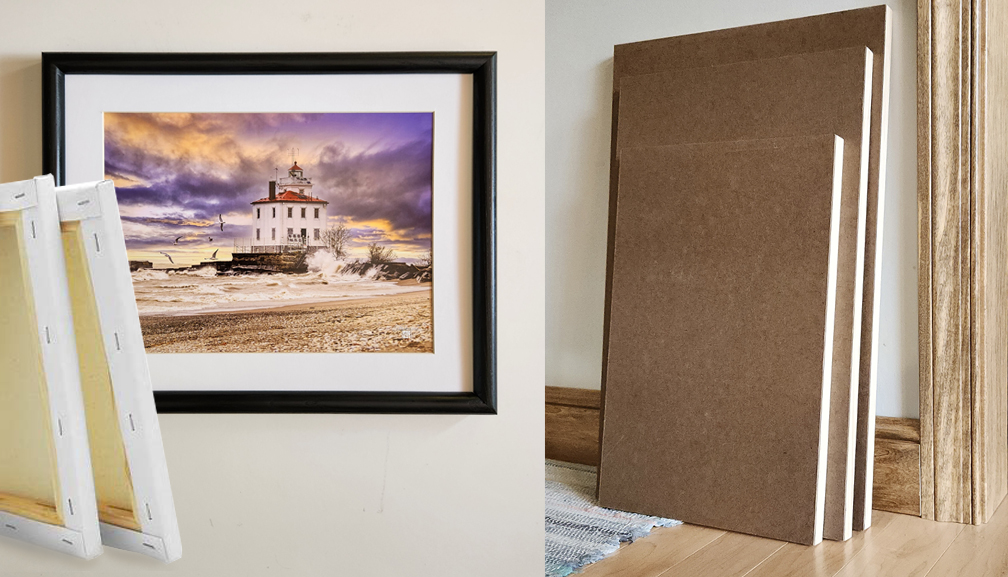
First things first, let’s break down what we’re talking about here. When you possess a stunning piece of art on canvas, you need a way to display it. There are a few popular methods: cradles, stretcher bars, and the classic matted and framed approach. Each has its own charm, but I firmly believe cradles are where it’s at. Let me explain why.
- Cradles
- Stretcher Bars
- Matted and Framed
Cradles: The Superstars of Canvas Mounting:
Canvas can be mounted onto what is commonly called a cradle. Once mounted on a cradle it looks nearly the same as a canvas mounted on stretcher bars. Cradles can be purchased ready-made or as I do, custom made in the studio.
Besides mounting the canvas onto the cradle, you can also paint directly on a ready-made cradle, prepare the cradle surface by adding texture, adding layers of gesso, sanding in between the layers for a smooth surface or by working directly onto the wood.
Stability and Durability:
Cradles are basically wooden frames that your canvas is mounted on, and they offer incredible stability. Unlike stretcher bars, which can warp and loosen over time, cradles keep your canvas tight and secure. The mounting board is attached to the sides so there is no way that it will become out of square. No sagging or wobbling here!
Aesthetic Appeal:
Have you seen how sleek cradled canvases look? They have this modern, minimalist vibe that really enhances the artwork. Stretcher bars often need a frame to look complete, but cradles can stand alone beautifully. The canvas is adhered to the cradles’ surface with a permanent PH neutral adhesive.
There are two ways to finish the look on a cradle…
The canvas can be finished by wrapping it around the cradle’s sides and folded at the corners. Held with glue instead of staples or nails, it looks finished without a frame. If you are making your own cradle, as I do, the sides can be any width you would like to add to the aesthetics of the artwork.
If you are mounting the artwork on a cradle instead of a blank white canvas, you may not want to lose some of the image, so you can mount it on a cradle the same size as the artwork. Trim the canvas with a razor knife to the exact size of the cradle AFTER the artwork is adhered to the mounting board. The exposed wood sides can be stained or painted to coordinate with the artwork. I, myself, often hand paint the sides to make it look like the image is wrapping around the cradle, even with my Altered Reality photographs. It’s amazing that you cannot tell which part is photograph and which is hand painted!
Ease of Display:
One of my favorite things about cradled canvases is that they’re ready to hang right out of the box. No need to mess around with additional framing or matting. Just pop a nail in the wall, and you’re good to go. It’s perfect for those of us who might not be the handiest with tools, don’t want to have to pick out a frame or who want that minimalist look.
Protection of Artwork:
Cradles do an excellent job of protecting the edges and corners of your canvas. Stretcher bars and frames can sometimes lead to damage, especially if you’re moving pieces around a lot. Trying to ship artwork is always a concern, but cradles will get the artwork where it needs to go much safer. Even the center of the canvas cannot get torn when mounted on a cradle.
Let’s Compare: Cradles vs. Stretcher Bars and Framed Canvas
Cradles vs. Stretcher Bars:
Canvas can be stretched onto stretcher bars. This is a common way to mount a canvas. You can purchase canvas already mounted on stretcher bars or you can stretch the artwork onto the stretcher bars after it is painted.
As an artist, you can stretch the canvas and prepare it with gesso before you start the creativity, but as a recipient of a completed artwork that is unmounted, the painting can become problematic if you want it mounted on stretcher bars. The canvas still needs to be stretched but is not near as flexible and compliant as it was when a clean, untouched canvas.
The paint will not allow the canvas to draw as tight onto the bars as it would have before painted on. The process of stretching becomes hard to do and even harder to keep the stretch even without the paint being affected.
Keeping the canvas stretched onto the bars needs the aid of nails or staples. If framing the stretched canvas, the frame will hide these, but if you don’t plan to frame the artwork then you will need to wrap the canvas around one more edge and staple it inside the stretcher bars.
When you compare cradles to stretcher bars, the differences are clear. Cradles offer better stability, they look more finished on their own, and they’re easier to display. Plus, they protect your canvas better over the long haul. Stretcher bars might be a bit cheaper upfront, but cradles are a worthwhile investment.
Cradles vs. Matted and Framed Canvas:
Now, matted and framed canvases have their own classic appeal, but they can be bulky and expensive. Have you priced frames lately? They can cost as much as the artwork you are framing!
Another consideration…watercolors and drawings are commonly finished in a mat and framed, but canvases usually are not.
Canvas can be safely framed under glass, as long as there is air between the glass and the canvas. That can be achieved with adding a mat between the glass and the artwork, but do you want to be unconventional in your finishing of canvas artwork? Not a bad thing, just something to consider.
Cradled canvases, on the other hand, give you a clean, modern look without the need for heavy frames. They’re cost-effective and easier to handle, especially if you like changing up your displays often.
Why Artists Love Cradles:
Many artists swear by cradles. They love the stability and the way cradles make their work look gallery-ready without extra fuss. Plus, galleries and exhibitions are increasingly favoring cradled canvases for their sleek, contemporary style.
This is how its’ done:
I have my husband build my own cradles instead of purchasing them because he is willing to create them as a fine piece of furniture with hidden pegs instead of screws, nails or only glue.
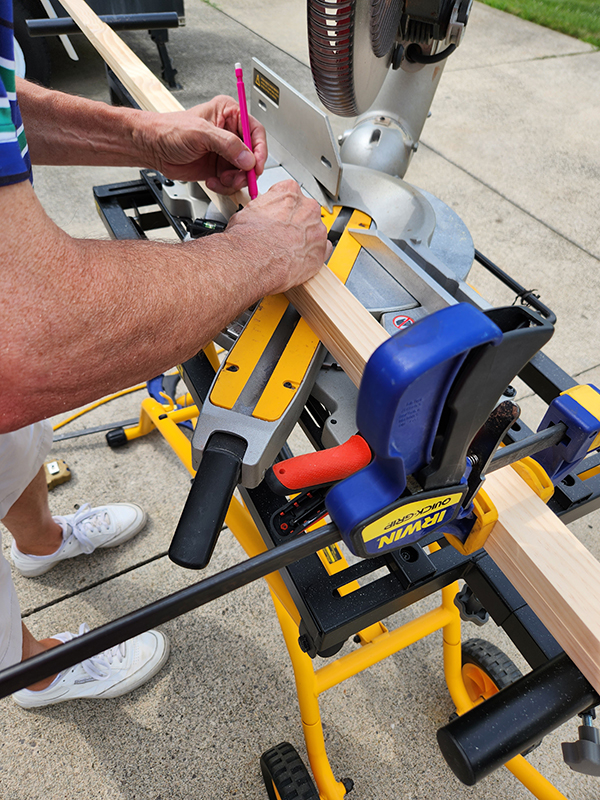
After selecting excellent pieces of wood for the cradle, they need to be accurately measured and the ends cut at 45-degree angles. 2 boards for the ends and two boards for the sides to make a complete frame.
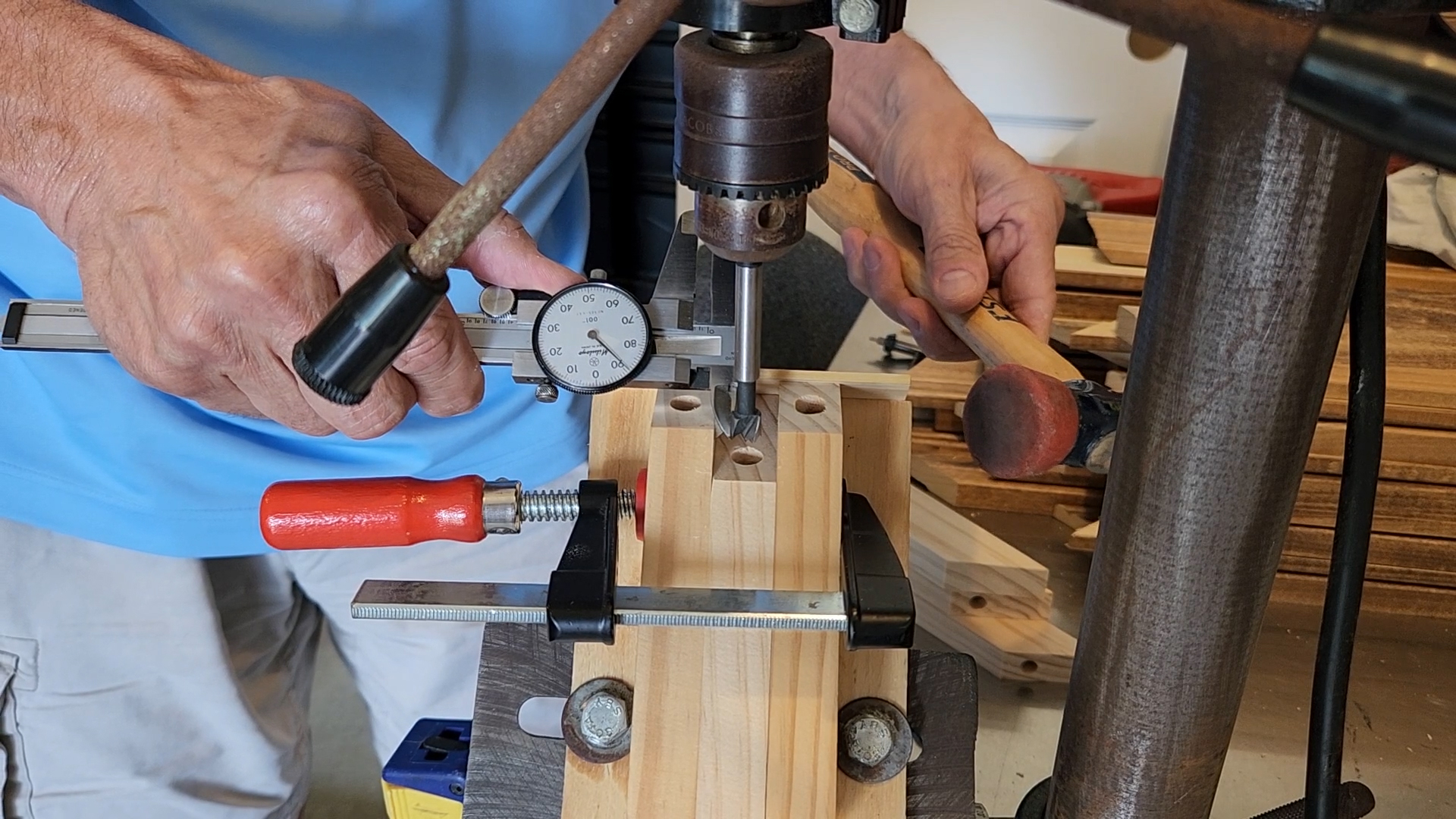
Once they are cut, holes are drilled into the angled ends for pegs to hold them together, then glued.
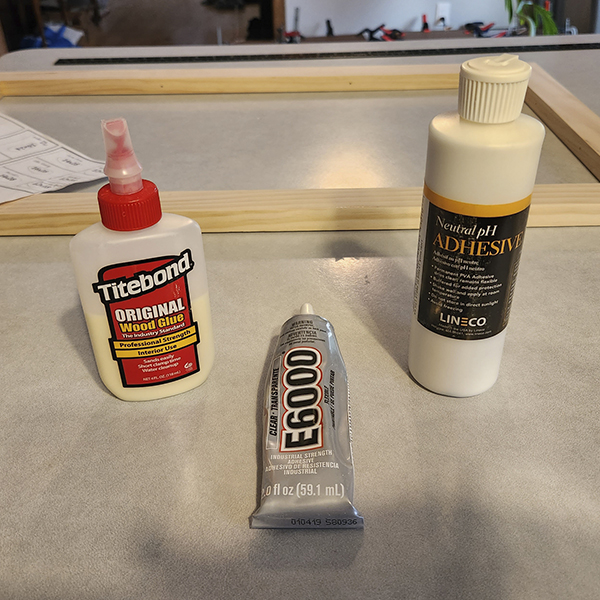
Throughout the process of making the cradle, I use three types of glue.
- The cradle sides and pegs use wood glue, and then clamped for 24 hours..
- To attach the backing board, that is cut to the exact size of the finished framing, I use E6000, then clamp it all together for another 24 hours.
- The neutral pH Adhesive is applied to the backing board with a roller and then the canvas to positioned in place and a brayer is used to make sure it is smooth and secure. The edges of canvas that wrap around the sides of the cradle are also clamped for another 24 hours. Weights are set on the canvas until the adhesive dries.
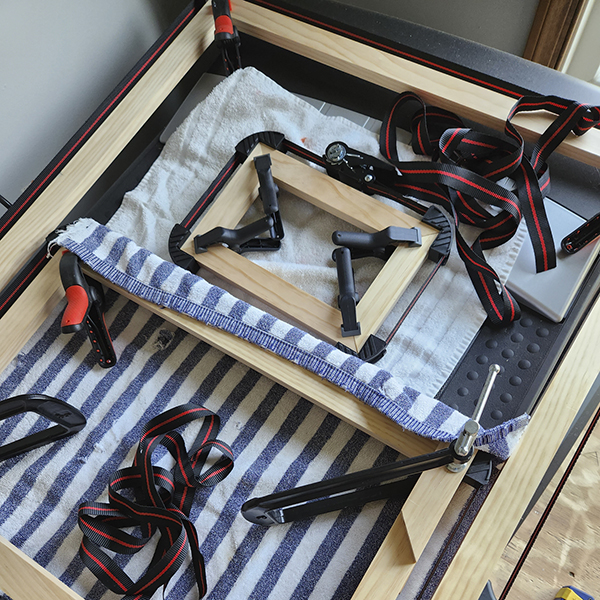
Cradles are pegged, glued and clamped for 24 hours
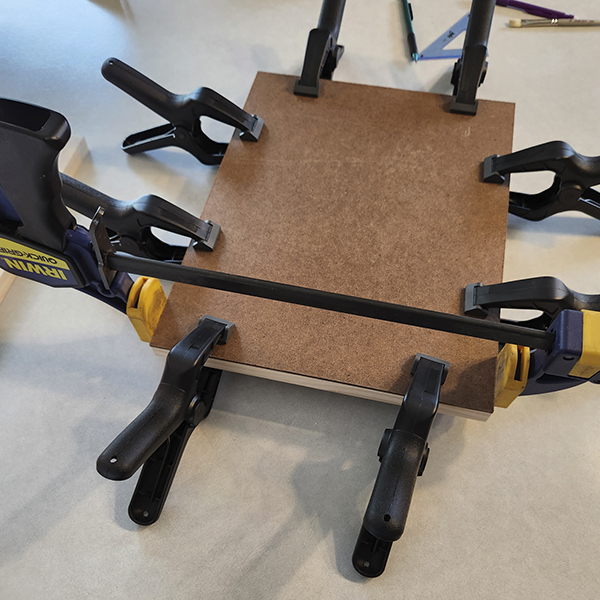
Once the cradle’s sides are complete, the carefully cut-to-size backing board is added. It too is glued and clamped for 24 hours.
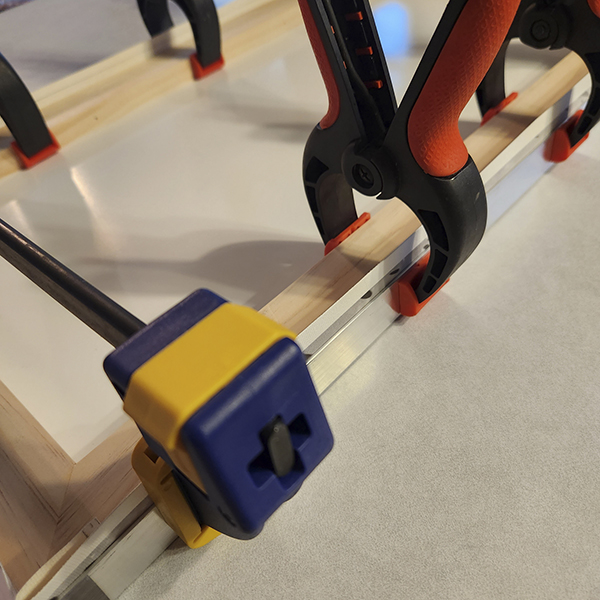
Both the back and sides of the canvas are secured with pH neutral adhesive. Metal angle iron and clamps are used to keep the canvas tight to the cradle while it dries. Weights are applied to the back to make sure that the canvas is 100% adhered flat to the backing board while it dries.
- After 24 hours, any extra canvas is cut with a razor knife to align with the edge of the cradle.
- If the canvas edges are still white, they will be hand painted.
- Alternately, the canvas can be cut along the front edge of the cradle and the cradle will be stained and varnished or painted, depended on the aesthetics I am going for.
- The last step is to add your choice of hardware for hanging the masterpiece.
A Smart Investment:
When you think about the long-term benefits, cradles really are a smart choice. They save you money on framing, they’re easier to maintain, and they keep your artwork looking its best. It’s a win-win!
Wrapping Up:
So, there you have it – cradles are the superior choice for mounting your canvas artworks. They offer unbeatable stability, a modern aesthetic, easy display, and top-notch protection.
To the collectors… Next time you’re purchasing a custom piece of art that will be created on a canvas, ask the artist to have the artwork mounted on a cradle for you.
And to the artists… Next time you’re getting ready to showcase your latest masterpiece, give cradles a try. I promise, you won’t be disappointed!
Happy creating and displaying, my friends!



0 Comments